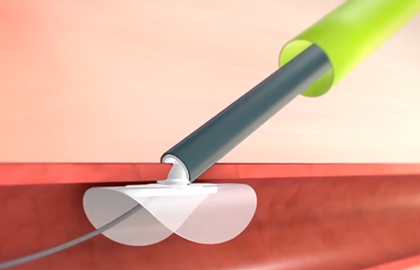Courtesy of Dr. Guillermo Migliaro.

Even though studies have shown the transradial approach is safer than the femoral, especially in high risk subgroups ─ mainly STEMI patients ─ the femoral access site continues to be widely used.
Though manual compression is the standard technique to obtain hemostasis of the femoral artery after sheath withdrawal, vascular closure devices (VCDs) were developed as an alternative, especially for patients at higher risk of vascular complications, such as those on anticoagulants.
While these devices have been shown to reduce bleeding and vascular complications incidence, they have also been associated with serious complications, such as limb ischemia, need for surgery or infections.
The AHA clinical guidelines have given a Class II recommendation to VCDs when used to get faster hemostasis and improve patient comfort. But, at the same time, they give VCDs a Class III recommendation when used to reduce vascular complications.
The present registry compares the impact of VCDs vs. manual compression in short term mortality incidence (30 days) in patients undergoing PCI via femoral access site.
This national registry uses data from the British Society of Cardiovascular Interventions in the UK; it includes all PCI procedures from 2006 to 2011, both for elective and ACS indications (n=271.845).
The analyzis excluded patients with prior interventions via transradial access site and patients with no specific hemostasis method. Clinically relevant subgroups were propensity score matched.
Manual hemostasis was obtained in 40.1% of patients (n=109.001) and VCDs were used in 59.9% patients (n=162.844). Patients in the VCD group had less comorbidities, primary PCI and cardiogenic shock (p< 0.001).
Mortality at 30 days was lower in the group treated with VCDs compared to the manual compression group 1.4% vs. 2.4% HR 0.58; 95% CI 0.54-0.61 (P<0.0001), and it was still significant after propensity score matching: 1.8% vs. 2.0% HR 0.91; CI 95% 0.86-0.97 (p<0.001).
Subgroup analyzis showed mortality reduction was higher in women: HR 0.85; CI 95% 0.77-0.95 (p=0.037), in those admitted with ACS: HR 0.88; CI 95% 0.83-0.94 (p=0.0027) or recent lysis: HR 0.63; CI 95% 0.40-1.01 (p=0.0001).
Conclusion
The study concludes that, compared to manual compression, VCDs are associated with a modest reduction of short term mortality incidence.
Editorial Comment
Though significantly large and variable-adjusted, given its nature, this registry, fails to provide conclusive results, since confounding factors might have been unaccounted for.
The only irrefutable data obtained from the database are mortality rates, there are no data on other complications, mostly vascular, which could have been presented with VCDs.
However, it contributes relevant information on the use of VCDs that may encourage their use and lead to changes in clinical guideline recommendations.
Original Title: Relation Between Femoral Vascular Closure Devices and Short Term Mortality from 217845 Percutaneous Coronary Intervention Procedures Performed in the United Kingdom Between 2006 and 2011. A propensity Score Corrected Analysis from the British Cardiovascular Intervention Society.
Reference: Vasin Farooq et al. Circ Cardiovasc Interv.2016;9:e003560.
Courtesy of Dr. Guillermo Migliaro. German Hospital, Buenos Aires, Argentina.
We value your opinion. You are more than welcome to leave your questions, thoughts, comments and suggestions here below.




